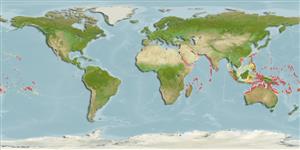Common names from other countries
Teleostei (teleosts) >
Gobiiformes (Gobies) >
Microdesmidae (Wormfishes) > Microdesminae
Etymology: Gunnellichthys: From Gunnel, a small eel shaped marine fish of unknown origin, 1686 (Ref. 45335).
More on author: Smith.
Environment: milieu / climate zone / depth range / distribution range
Ecology
Marine; reef-associated; depth range 1 - 20 m (Ref. 9710), usually 6 - 20 m (Ref. 27115). Tropical; 23°C - 27°C (Ref. 27115); 30°N - 24°S
Indo-Pacific: East Africa to Marquesan and Society islands, north to Ryukyu Islands, south to the southern Great Barrier Reef. Record from Mauritius (Ref. 9408) requires verification (Ref. 33390).
Size / Weight / Age
Maturity: Lm ? range ? - ? cm
Max length : 15.0 cm SL male/unsexed; (Ref. 48637)
Inhabits coastal sand slopes, subject to strong currents (Ref. 48637). Found over open sandy areas, sometimes with sparse plant growth. Solitary. Feeds on small benthic and pelagic crustaceans (Ref. 1602).
Life cycle and mating behavior
Maturities | Reproduction | Spawnings | Egg(s) | Fecundities | Larvae
Randall, J.E., G.R. Allen and R.C. Steene, 1990. Fishes of the Great Barrier Reef and Coral Sea. University of Hawaii Press, Honolulu, Hawaii. 506 p. (Ref. 2334)
IUCN Red List Status (Ref. 130435)
CITES (Ref. 128078)
Not Evaluated
Threat to humans
Harmless
Human uses
Fisheries: commercial; aquarium: commercial
Tools
Special reports
Download XML
Internet sources
Estimates based on models
Preferred temperature (Ref.
115969): 25.8 - 28.9, mean 27.7 (based on 296 cells).
Phylogenetic diversity index (Ref.
82804): PD
50 = 0.5078 [Uniqueness, from 0.5 = low to 2.0 = high].
Bayesian length-weight: a=0.00389 (0.00180 - 0.00842), b=3.12 (2.94 - 3.30), in cm Total Length, based on all LWR estimates for this body shape (Ref.
93245).
Trophic level (Ref.
69278): 3.3 ±0.41 se; based on food items.
Fishing Vulnerability (Ref.
59153): Low vulnerability (10 of 100).
